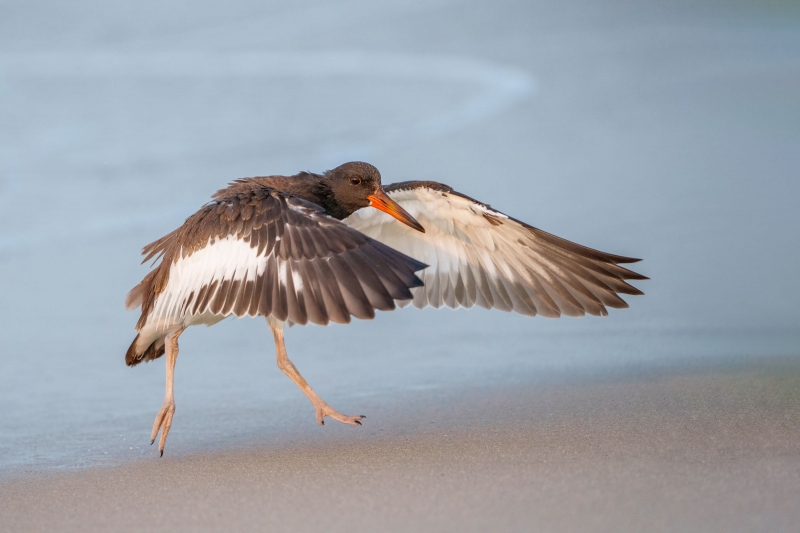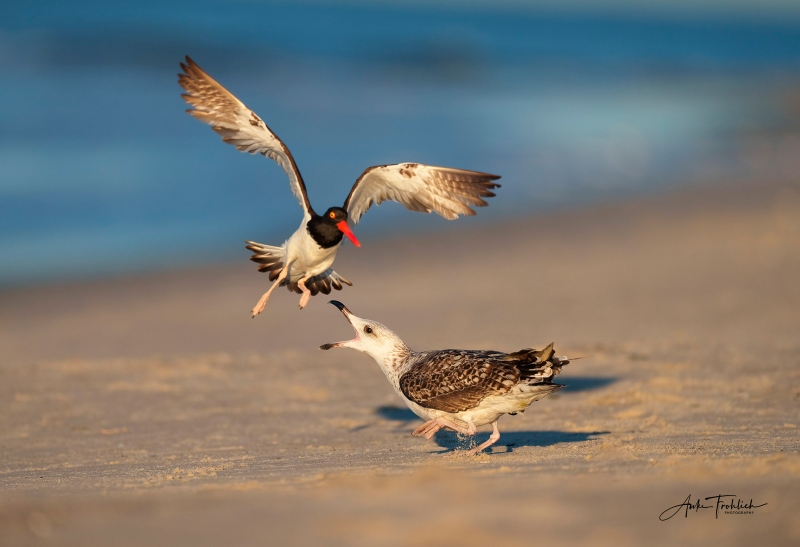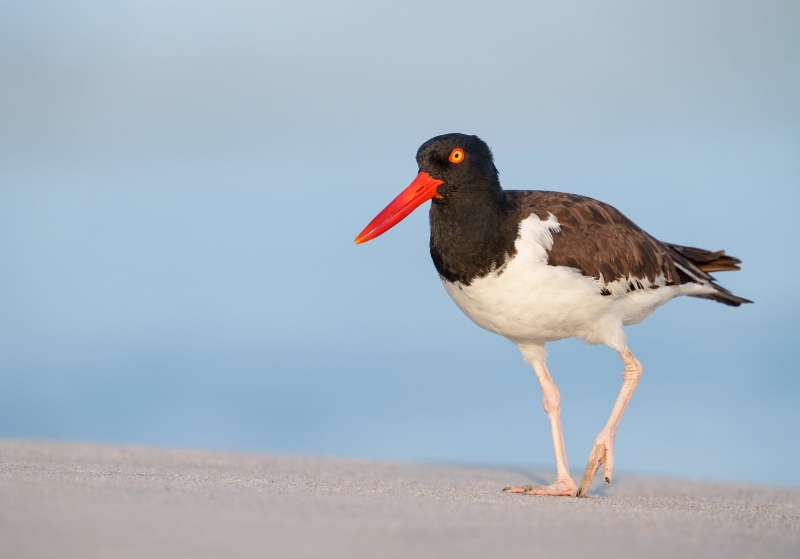What’s Up?
While we continue to battle the wind against sun conditions, we have continued to make some very fine images each and every session. You can see three of those in today’s blog post. Your comments on each image are welcomed.
On Thursday morning there were five of us in good position to create some pre-dawn skimmer blurs. Rob from Maryland, a very nice man who had been hanging with us for a few days, asked if we should all go closer. I said that I thought that there was no need to do so. We all stayed and enjoyed some excellent blastoff action.
The distance from Point Lookout (to the east) to the Silver Point Jetty in Atlantic Beach (to the west) is about 10 miles. We had all noted a tame young Great Black-backed Gull standing on the smooth sand near the ocean. Anyhoo, the gull was no more than 10 yards from us when suddenly it flew up and dove into the water just a few feet from shore. It emerged with a foot long baby Sand Shark (Dogfish) in its bill. It took about five minutes to subdue and then swallow its prey. The five lucky photographers created more than a few images in that relatively short time. What luck that the gull got lucky in plain sight right in front of five bird photographers. Photos soon.
When the action was over, I asked Rob (with a smile on my face), “Are you glad that we did not all move up?”
Today is Friday 16 August 2024. We learned that the pale sunrises have been due to both marine haze and smoke from western US wildfires. After another excellent blast-off blur session at the beach, made a wiggle. Thanks to a great tip from good friend longtime NYC birder Peter Post, we found and photographed about a dozen juvenile Yellow-crowned Night-Herons at a nearby marina. Geri and I went for portraits and head shots and Anke went for flight. All of us succeeded. No surprise at all.
|
|
|
This image was created on 15 August 2024 on the first morning of the (extended) Combo IPT by Geri George. Seated on damp sand she used the knee pod technique with the hand held Sony FE 200-600mm f/5.6-6.3 G OSS lens (at 600mm) and The One, the Sony Alpha 1 Mirrorless digital camera. ) The exposure was determined using Zebra technology with ISO on the Thumb Dial. ISO 6400. 1/3200 second at f/6.3 (wide-open) in Manual Mode. AWB at 8:05:31am on a barely sunny morning with the sun muted by thick haze to the east. RawDigger showed the exposure to be dead-solid perfect. Tracking: Zone AF-C with Bird Face/Eye Detection performed perfectly. Click on the image to enjoy a larger, sharper high-res version. Image #1: American Oystercatcher juvenile flapping after bath
|
Geri Georg
With about two decades between IPTs, Geri Georg attended a Spring DeSoto IPT this past May. She had so much fun and learned so much that she returned for the Combo IPT. Geri is one of my many Canon to Sony converts. In short, she says with a big smile, “I love it!” She has never had a problem making sharp images. By learning and using Sony Zebras, she is constantly nailing her exposures. And she is an excellent student. I teach, pick the shutter speed that you need to make a sharp image and increase the ISO (using the Thumb Wheel) until you see some Zebras on the highlights (live in the viewfinder before you press the shutter button). There is no need to create and evaluate a test image to consistently cone up with perfect exposures. Anyhoo, Geri came up with the perfect ISO for the situation without even noticing that she was at ISO 6400! Image optimization by yours truly, BIRDS AS ART.
She has absolutely loved being on the beach with the skimmers and the terns.
|
|
|
This image was created by Anke Frohlich on the (extended) Combo IPT. Seated on the damp sand, she used the hand held Sony FE 600mm f/4 GM OSS lens and The One, the Sony Alpha 1 Mirrorless digital camera. ISO 1000: 1/6400 sec. at f/4 (wide open). Tracking: Zone/AF-C was active at the moment of exposure and performed perfectly. Be sure to click on the image to enjoy the larger version. Image #2: American Oystercatcher buzzing first summer Great Black-backed Gull |
Action Anke
Anke loves to photograph birds in flight and in action. She almost always sets up with a very fast shutter speed even when working in low light conditions and thus needs very high ISOs. “I will always go for action over the art shots. I need to be ready,” she says. When Anke saw the adult oystercatcher begin attacking the gull to protect its two chicks, she moved back quickly (human zooming so to speak) while staying on sun angle. When she’d see the oystercatcher fly at the large predator, she would raise her lens, acquire focus on the gull’s head, and begin firing. Her timing was perfect for Image #2.
While she was making this great image, I was sitting in about a foot of Atlantic Ocean water trying to avoid being knocked on my ass by the occasional small wave. I was way off sun angle and got nothin’.
You can see more of Anke’s excellent bird photography on her Instagram page here or check her out further online here.
|
|
|
This image was created by Arthur Morris at Nickerson Beach while leading the first (extended) Combo IPT. Seated on damp sand he used the heel pod technique with the I used the hand held Sony FE 300mm f/2.8 GM OSS lens (Sony E) with the Sony FE 2x Teleconverter and The One, the Sony a1 Mirrorless Camera. The exposure was determined using Zebra technology with ISO on the Thumb Dial. ISO 1250. 1/1250 second at f/6.3 (stopped down 1/3-stop in error) in Manual Mode. AWB at 6:54:34pm late on a sunny afternoon. RawDigger showed the raw file brightness to be perfect. Tracking: Expand Spot AF-C AF with Bird Face/Eye Detection performed perfectly. Be sure to click on the image to enjoy a high-res version. Image #3: American Oystercatcher male atop a mound in gorgeous light |
Art for artie
Anke calls images like this beauty shots. I call them BIRDS AS ART — clean, tight, graphic, and colorful with a lovely, de-focused background. And the somewhat patriotic color scheme works for me as well. When I saw this bird pause atop a clean mound of sand, I hustled to my right to get on sun angle, flipped out the rear screen, put on my reading glasses, and prayed for the bird to stay for a few moments as I sat down slowly so as not to scare him off. I supported the lens with between my heels quickly found the bird in the viewfinder, and fired about two dozen frames, the first 12 at the exposure above, and then another 12 1/3 stop lighter. Only two of the slightly darker frames had the perfect head angle.
The key to the success of this image was that with the bird elevated on a rise, the Atlantic Ocean blue background was a relative mile away from the bird. The resulting image was exactly what I had envisioned when I saw the bird on the smooth mound of sand.
Typos
With all blog posts, feel free to e-mail or to leave a comment regarding any typos or errors.

















Beautiful! Nice to see you are still going to Nickerson. Such a great spot!
Typo: American Oystercatcher buzzing first summer Great Black-backed Gull on Homer IPT? 😉
P.S. All three artistic!
Not exactly 🙂 Fixed.
with love, artie
Great one and all. Thanks to all for sharing.
Thank you sir.
a
I like all three images but the third one is my favorite, even without the action.
Seeing those photos makes me feel that I’m still there, next to you, taking photos on Nickerson Beach.
WOW! 12 1/3 stops lighter??
Word added for clarification. Thanks
a